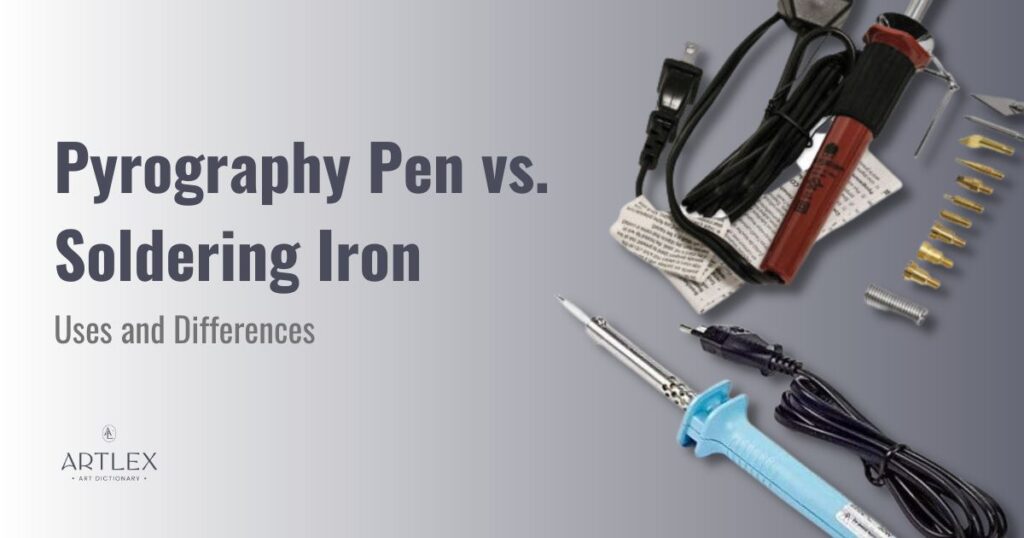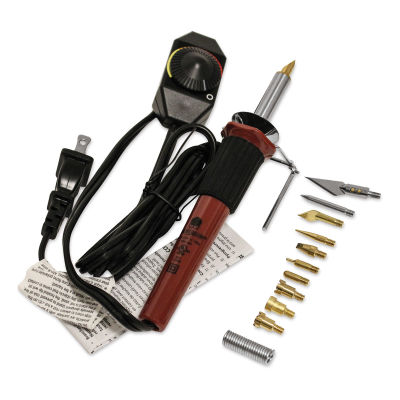 If you’re considering picking up wood burning as a hobby, you must start with the right tools for the job.
If you’re considering picking up wood burning as a hobby, you must start with the right tools for the job.
One of the most common considerations for new wood-burning enthusiasts is whether a soldering iron makes a reliable replacement for a specialty pyrography tool, as both are pen-shaped implements with a heating element and precision capabilities.
To help you decide which is best for your wood-burning projects, we’ll take a closer look at a pyrography pen vs. soldering iron, including their intended uses and some essential differences that set the tools apart.
What Is a Pyrography Pen?

Pyrography pens are heated, pen-shaped devices designed for precisely charring wood material. Wood burners use them for creating details, designs, and textures on the “canvas,” often a pre-shaped piece of treated wood.
They consist of a plastic handle with a comfortable, rubberized grip, a metal flange, and a tapered end with a heating element. The end is open, allowing the user to swap out different shapes and sizes of iron or copper tips depending on the wood-burning project they have in mind.
You’ll find pyrography tools sold as kits under names such as wood burners, wood-burning pens, or wood-burning tools.
For a guide on purchasing the best pyrography pen for your projects, see our guide on the Best Pyrography Kits.
Pyrography Pen Advantages and Disadvantages
Pyrography pens offer many “quality of life” advantages for artists, making them more comfortable to hold and effective as a specific wood-burning tool.
Artists can use the dial on the tool to reach the desired temperature and adjust as needed throughout the burning process, depending on the different materials they’re using.
Another advantage is that wood-burning tools have a much larger tip variety, allowing artists to create tiny details and precise lines. These tips also retain their heat better, ensuring a more even finish.
They also tend to be more lightweight and won’t tire out the hand as quickly as using a soldering iron.
However, wood-burning tool kits are more expensive than soldering irons, and their ability to hold heat means waiting for the pen to cool down before swapping in a new tip.
What Is a Soldering Iron?
Soldering irons or soldering guns are devices for melting solder, another name for metal alloys. They have a similar shape to wood-burning pens, with interchangeable tips and a heat source.
While they come in various sizes, depending on the type of work, we’ll focus on the smaller hand tools.
Soldering Iron Advantages and Disadvantages
One of the key advantages of soldering irons is that the larger tips can cover a larger area than most standard wood-burning pen tips. This high coverage makes quick work of backgrounds or coloring in large shadows.
The copper material is also highly conductive, allowing the tip to heat up quickly.
However, that doesn’t necessarily make them a good tool for pyrography.
Copper is poor at retaining its temperature over time. While you won’t have to wait as long to swap the tip, you do have to contend with your soldering iron’s fluctuating temperature range.
Additionally, soldering irons are often much less expensive than wood-burning pens, making them a tempting option for those trying out the art form for the first time. You can find a cheap soldering iron for as little as $15, compared to $30 for wood burners.
How Are a Pyrography Pen and Soldering Iron Different?
Now that we’ve gone over the basics of each tool, we’ll dive into some of the critical differences.
Uses
An artist can use a wood-burning pen to precisely char and texturize wood, creating designs that are highly intricate and decorative.
Soldering guns, on the other hand, are more common in industrial settings rather than artistic ones.
Soldering irons are a standard tool in electronics work, such as fusing metal on a printed circuit board or splicing wires.
Tip Variety
A wood-burning pen can use different pointed tips to create designs in various shapes and sizes. Choosing the right tool gives you the most control over the final outcome of your pyrography project.
They come in two general types – solid point and wire nib.
Examples of solid point tips include:
- Calligraphy tips for creating very fine lines and letters.
- Dot tips for making varying depths of holes.
- Tear-drop-shaped shading tips for varying shades and tones.
- Groove tips for deep lines.
- Universal tips are shaped similarly to broad line markers. Holding it at different angles allows for wide or narrow lines.
Wire nib tips use larger or smaller wire gauges to burn highly detailed pieces. The following are the most common shapes.
- The skewed tip is ideal for angles and long lines.
- Artists use a spear tip for small detail work.
- A round tip allows the artist to minimize how deep the burn is.
- Chisel tips are “square-shaped,” with a flat top.
- The ballpoint tip provides natural flow and movement, similar to handwriting.
Soldering irons have far fewer tip options than a wood burner would need to create highly detailed works.
Here are a few common tip shapes:
- The tapered chisel is for melding cables, larger surfaces, or desoldering.
- The conical tip works well in tight spaces.
- A hoof tip holds a lot of solder material and spreads it across a more significant area.
Tip Material
When it comes to wood burning, iron alone can’t handle as much heat as an alloy. That’s why pyrography tips consist of nichrome for wire nib and brass for solid point.
Nichrome is an iron, chromium, and nickel alloy that is highly resistant to rust, corrosion, and heat, making it ideal for wood-burning pens. It can withstand temperatures of up to 2000 degrees Fahrenheit, far higher than necessary for any wood-burning project.
It also heats up much faster than iron tips, turning red hot in a matter of seconds.
Soldering iron tips, in most cases, consist of a copper core with an iron plating.
An iron coating is used to mitigate heat loss, as it holds on to heat longer and helps regulate the temperature despite environmental conditions, such as a frigid room.
Temperature Control and Heat Retention
A wood-burning pen has to get extremely hot, up to more than 1000 degrees Fahrenheit in some cases, because wood-burning art requires a broader range of temperature control.
The artist can create depth in their project through shadows and color gradients by using a higher temperature for darker areas and a lower temperature for lighter areas.
Because solder melts at relatively low temperatures, a soldering iron produces less heat than a wood-burning tool nor offers nearly the same amount of control.
For example, a cordless soldering iron works similarly to a butane torch. It doesn’t allow the user to achieve the right temperature through any means other than increasing or decreasing the gas flow.
That said, there are some temperature-controlled soldering stations that look very similar to a wood-burning iron. They are more prevalent in electronics work when a person might use a soldering iron with different makes and models of computer circuitry.
Grip
Wood-burning tools have a grip similar to a pencil, allowing the user to hold it comfortably for longer.
The position of the grip also helps keep the fingers safe from the high heat of the tip, as it has a metal flange just below it in case your hand slips forward.
When an electronics technician needs to melt solder on a circuit board, they’re only using a soldering iron for a few seconds at a time.
They also need to be careful not to accidentally touch the delicate circuitry or wires with their hands, as it can transfer skin oils or debris.
For that reason, soldering irons have a grip much higher up on the shaft, which allows for less control than offered by a proper pyrography pen but helps the user keep their hands far from the solder site.
FAQs
Are you still wondering whether you should use a soldering iron for successful wood burning?
We’ve answered some of the most common questions about the use of a pyrography pen vs. soldering iron for wood-burning projects.
Can I use a pyrography pen for soldering?
You can use pyrography pens for soldering. Some wood-burning tool kits even come with different tips specifically designed for metalworking.
Can a soldering iron be used for pyrography?
You can use a soldering iron for pyrography, but it won’t give you the same results as a wood-burning tool. The tips are too large to complete wood burns with fine details, and it doesn’t offer the same temperature variability for shading projects.
Is a wood-burning pen the same as a soldering iron?
Wood-burning pens are not the same as a soldering iron. A soldering iron has a lower maximum temperature and less tip variety than a wood-burning tool.
What is the difference between wood burning and pyrography?
Wood burning is an umbrella term for using a tool to change the color and texture of wood with heat.
Pyrography is when you burn designs or words into any material, such as leather, wood, or paper, with a precision tip. However, most people use the two terms interchangeably.
Final Thoughts
While you can use a soldering iron for wood burning, most soldering irons can’t achieve the same temperature, precision of detail, or control as a wood burning tool.
However, it can be helpful for practicing pyrography on scrap wood before investing in a wood burner.
Once you’ve got the hang of things, you might also find that a soldering iron tip is useful for covering large areas with lighter colors or handling easily-scorched softwoods.
In most cases, though, the best results come from using a specialized wood-burning tool, despite the extra cost and learning curve.
Now that you have a detailed comparison between pyrography pen vs. soldering iron, go ahead and buy what you think is appropriate for your project.
